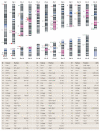Advances in autism genetics: on the threshold of a new neurobiology
- PMID: 18414403
- PMCID: PMC2756414
- DOI: 10.1038/nrg2346
Advances in autism genetics: on the threshold of a new neurobiology
Erratum in
- Nat Rev Genet. 2008 Jun;9(6):493
Abstract
Autism is a heterogeneous syndrome defined by impairments in three core domains: social interaction, language and range of interests. Recent work has led to the identification of several autism susceptibility genes and an increased appreciation of the contribution of de novo and inherited copy number variation. Promising strategies are also being applied to identify common genetic risk variants. Systems biology approaches, including array-based expression profiling, are poised to provide additional insights into this group of disorders, in which heterogeneity, both genetic and phenotypic, is emerging as a dominant theme.
Figures

References
-
- Fombonne E. Epidemiology of autistic disorder and other pervasive developmental disorders. J. Clin. Psychiatry. 2005;66(Suppl 10):3–8. - PubMed
-
- Blomquist HK, et al. Frequency of the fragile X syndrome in infantile autism. A Swedish multicenter study. Clin. Genet. 1985;27:113–117. - PubMed
-
- Jacquemont ML, et al. Array-based comparative genomic hybridisation identifies high frequency of cryptic chromosomal rearrangements in patients with syndromic autism spectrum disorders. J. Med. Genet. 2006;43:843–849. The numerous de novo deletions that are reported in this work have received relatively little attention but are probably important in the ASDs. These data also show that rare de novo mutations are likely to appear at particularly high frequencies in syndromic populations. - PMC - PubMed
-
- Sebat J, et al. Strong association of de novo copy number mutations with autism. Science. 2007;316:445–449. Beyond identifying important CNV likely to prove important to our understanding of the ASDs, this study highlights a significant difference in the frequency of de novo variants between simplex and multiplex families, raising the possibility that distinct mechanisms are involved in each. - PMC - PubMed
-
- Szatmari P, et al. Mapping autism risk loci using genetic linkage and chromosomal rearrangements. Nature Genet. 2007;39:319–328. This work — the largest ASD linkage study published to date — identifies a number of new loci that merit additional attention. Lack of overlap with previously published studies underscores the importance of genetic and phenotypic heterogeneity in ASDs. - PMC - PubMed
Publication types
MeSH terms
Grants and funding
LinkOut - more resources
Full Text Sources
Other Literature Sources
Medical

